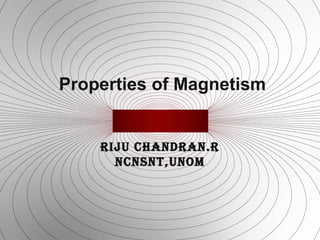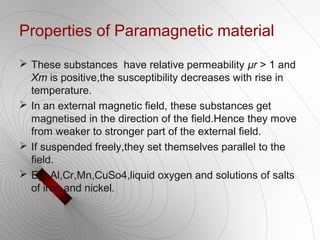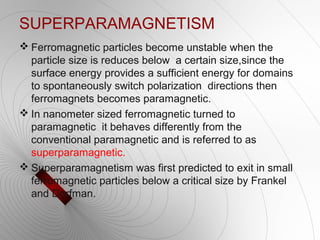Properties of Magnetism
- 1. Properties of Magnetism RIJU CHANDRAN.R NCNSNT,UNOM
- 2. MAGNETISATION (M) ? Magnetisation of a material is defined as the magnetic dipole moment induced per unit volume of the material. ? The unit of magnetisation is Amperes/meter. ? If ĄŪmĄŊ be the magnetic dipole moment of a specimen of volume ĄŪvĄŊ we can say that M = m/v. ? On an unmagnetized matter M will be 0 and when a matter is magnetized each atomic magnetic dipole will point in the same direction and M will be constant throughout
- 3. MAGNETIC INDUCTION (B) ? It is a process by which a substance, becomes magnetized by a magnetic field, i.e the induced magnetism is produced by the force of the field radiating from the poles of a magnet. ? It is also called magnetic flux density, a vector quantity used as a measure of the strength of a magnetic field. ? The unit of magnetic induction is weber/m2.
- 4. MAGNETIC FIELD INTENSITY(H) ? It is used to characterize the strength of an external field i.e. the magnetic field due to the external sources (electric current) only, excluding the contribution due to materialĄŊs internal magnetic field. ? It is also known as Magnetizing force or Auxiliary Magnetic field. ? Its unit is same as that of Magnetisation i.e Amperes/meter
- 5. MAGNETIC SUSCEPTIBILITY (Xm) ? It is defined as the ratio of the magnetisation(M) to the magnetic field intensity (H) ? Xm = M/H ? The magnetic susceptibility of a material is defined as the intensity of magnetisation acquired by the material for unit field strength.
- 6. MAGNETIC PERMEABILITY (?) ? Magnetic permeability of a medium is defined as the ratio of magnetic induction to the intensity of the magnetising field. ? ? =B/H
- 11. DIAMAGNETISM ? It occurs in those substances whose atoms consist of an even number of electrons,thus the electrons of such atoms are paired. ? Electrons in each pair have orbital motions as well as spin motions. ? Magnetic dipole moment of the atom is zero. ? In diamagnetism the electron moving in a direction so as to produce a magnetic field in the same direction as the external field applied, thus it acquired an effective magnetic dipole moment which is opposite to the applied field.
- 12. Properties of Diamagnetic material ?The susceptibility(Xm) of a diamagnetic material has a low negative value.It is independent of temperature. ?In an external magnetic field, they get magnetised in a direction opposite to the field and they have a tendency to move away from the field. ?If suspended freely, they set themselves perpendicular to the field. ?Eg: Pb,Au,Ag,Zn,Bi,Sb etc
- 13. PARAMAGNETISM ? In paramagnetic material,the magnetic field associated with the orbiting and spinning electrons do not cancel out ? The molecules in paramagnets behave like little magnets ? When an external field is applied it will turn and line up with its axis parallel to the external field. ? The diamagnetic force of repulsion is also present here but it is not so strong. ? When a paramagnetic substance is heated the thermal agitation of its atom increases then the alignment of dipoles become more difficult,thatĄŊs why the magnetization of paramagnetic substance decreases as the temperature of the substance increases.
- 14. Properties of Paramagnetic material ? These substances have relative permeability ?r > 1 and Xm is positive,the susceptibility decreases with rise in temperature. ? In an external magnetic field, these substances get magnetised in the direction of the field.Hence they move from weaker to stronger part of the external field. ? If suspended freely,they set themselves parallel to the field. ? Eg: Al,Cr,Mn,CuSo4,liquid oxygen and solutions of salts of iron and nickel.
- 15. FERROMAGNETISM ? Ferromagnetic substances are very strongly magnetic. ? A ferromagnet has a spontaneous magnetic moment. ? Due to spin of electrons they have a net intrinsic magnetic dipole moment. ? The interaction between the neighbouring atomic magnetic dipoles is very strong,it is known as spin exchange interaction and is present even in the absence of an external magnetic field. ? All magnetic moments within a domain will point in the same direction resulting in a large magnetic moment. ? When a ferromagnetic material is heated to a very high temperature, the thermal vibrations may become strong enough to offset the alignment within a domain and the material loses its ferromagnetic property and behaves like
- 16. Paramagnetic material.The critical temperature above which a ferromagnetic material becomes a paramagnetic is called Curie temperature.
- 17. Properties of ferromagnetic material ? The value of ?r and Xm of these materials are very large. ? They get strongly magnetised in the direction of the external field and so they are strongly attracted by magnets. ? They set themselves parallel to external field if suspended freely. ? These materials exhibited the phenomenon of Hysteresis ? As temperature increases the value of Xm decreases.Above a certain temperature known as curie temperature ferromagnets become paramagnet. ? Eg: Fe,Ni,Co etc
- 18. SUPERPARAMAGNETISM ? Ferromagnetic particles become unstable when the particle size is reduces below a certain size,since the surface energy provides a sufficient energy for domains to spontaneously switch polarization directions then ferromagnets becomes paramagnetic. ? In nanometer sized ferromagnetic turned to paramagnetic it behaves differently from the conventional paramagnetic and is referred to as superparamagnetic. ? Superparamagnetism was first predicted to exit in small ferromagnetic particles below a critical size by Frankel and Dorfman.
- 19. ? The first example of superparamagnetic property was reported in literature as early as 1954 on nickel particles dispersed in silica matrix. ? An operation definition of superparamagnetism would include two requirements : 1. The magnetization curve must show no hysteriasis, since that is not a thermal equilibrium property. 2. The magnetization curve for an isotropic sample must be temperature dependent to the extent that curves taken at different temperatures must approximately superimposed when plotted against H/T after correction for the temperature dependence of the spontaneous magnetization.
- 20. APPLICATIONS ? BIOMEDICAL APPLICATIONS : ? Detection: MRI Magnetic Resonance Imaging ? Separation: Cell-, DNA-, protein- separation, RNA fishing ? Treatment: Drug delivery, hyperthermia, magnetofaction ? OTHER APPLICATIONS : ? Sensors: high sensitivity (GMR, BARCIII) ? Ferrofluid: Tunable viscosity, Stealth aircraft.
- 21. THANK YOU..





















